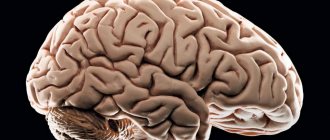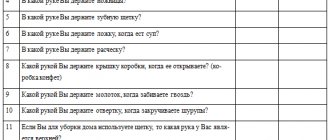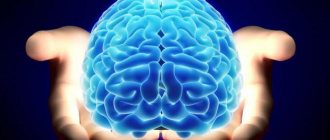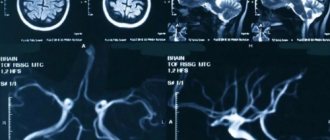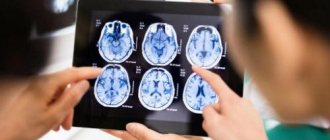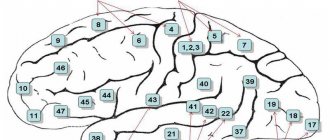“The left hemisphere of the brain is responsible for logical thinking, and the right hemisphere is responsible for creative thinking” - this “saying”, like many others like it, is very common not only among ordinary people, but also among specialists - even in books devoted to correct thinking , self-development and some other similar topics you can find a lot of them. But what is most interesting, surprising and strange is that these myths, one can put it bluntly, relate very, very little to the true state of affairs.
The myth that the cerebral hemispheres are functionally asymmetrical is one of the most popular myths regarding the brain that can be found today. Along with the myth that a person uses only 10% of his brain, he is, perhaps, a leader.
Despite this, even seemingly professional specialists with serious scientific knowledge and all kinds of degrees and titles often claim that this myth is the purest truth, and “stuff” it into the minds of ignorant people. The good news is that the myth about functional asymmetry of the cerebral hemispheres has been dispelled for quite some time. But let's not get ahead of ourselves.
Necessary conditions for child brain development
Nature has provided the human brain with a huge number of neurons that make up its core. Their diverse connections provide consciousness, thinking, memory, coordination and functioning of the entire organism. It is their formation that ensures the development of the brain.
The active process occurs until the child is three years old, after which the rate of development decreases significantly. Full physiological formation is completed by the age of 6-7, when a person is completely ready to perceive information, analyze it and conscious mental activity.
Researchers identify the following important factors influencing brain development:
- Speech. Verbal information received by the child becomes the main stimulant. The earlier and more language exposure an infant receives, the faster the brain develops. Verbal information stimulates the formation of connections for processing incoming information. It is important to understand that it is impossible to utter any word without hearing it at least once. Parental speech establishes vocabulary and communication skills in the first 2-3 years after birth.
- Stability and stress. The baby's brain instantly reacts to any external stimuli. A stable, calm environment provides normal conditions for development. Stresses that generate internal irritants become depressing factors for him. The child’s brain completely switches to such influences. Prolonged stressful situations lead to the production of cortisol and other dangerous hormones that change the entire brain structure.
- Emotions. Positive emotions in a child contribute to normal brain development. The caring attitude of parents and a favorable external environment create the basis for the formation of a response to future learning. It establishes trust and the necessary relationships between the baby and adults.
- Praise. Research has shown that praising a child's efforts between the ages of 1 and 3 stimulates a desire to broaden his or her horizons in the future. It is important to understand that rewarding diligence, not praising innate talents, has a positive effect.
- Cry. It has been established that the lack of response to a baby's crying disrupts normal brain development, increasing the impact of harmful stress. Parents' attention to their baby's crying lays the foundation for trust and affection.
There is considerable debate about the impact of television on a child's brain development. Most psychologists agree that it cannot be considered an assistant in this important process. Television information is practically not deposited in the infant brain. At the same time, the same information heard from the mother’s lips is absorbed well.
The nature of the left hemisphere
Left-hemisphere people are often emphatically rational and reasonable. They write a lot and willingly, they easily remember long texts, and their speech is correct. They are characterized by a heightened sense of duty, responsibility, integrity, and the internal nature of processing emotions. They often occupy administrative positions, but they lack flexibility, spontaneity and spontaneity in expressing feelings. They prefer to act according to pre-drawn up schemes and stencils, and have difficulty rebuilding their relationships.
Exercises to develop the left hemisphere
The human brain is designed in such a way that its hemispheres are endowed with different abilities. The left hemisphere is responsible for the following functions:
Analytical thinking, logic and reasoning. Facts are analyzed, numbers and mathematical symbols are recognized.
- Language abilities, understanding the literal meaning of words.
- Sequential, step-by-step processing of information.
- Mathematical abilities.
- Reading and writing abilities.
In addition to analysis and logical thinking, this hemisphere controls the movement of the right half of the body.
To develop the left hemisphere, the following exercises are recommended:
- Daily solution of mathematical problems with elements of logic. They are compiled taking into account the age of the child. You can give an example of a simple task. Two children (A and B) received a box of chocolates with 10 candies as a gift. One of them (A) ate some sweets from his box, and B ate all the rest in it. Question: how many sweets do the children have left between them? The answer is candy in the 20th, i.e. 10 pieces.
- Solving crosswords, chainwords, puzzles. You can pay attention to a popular trend - Sudoku.
- Physical exercise. Priority is placed on moving the right limbs and loading all types of muscles located on the right side of the body.
- Massage. Points that stimulate the functioning of the cerebellum have been identified. Massaging the point located at the base of the big toe on the right foot helps.
Important! For the development of the left hemisphere of the brain, training in logic and ingenuity is useful. It should be noted that the school curriculum is largely aimed at the development of this particular hemisphere.
Functions
All parts of the brain stem are equally necessary. They provide people with the opportunity to smell, hear sound, understand speech, think about any serious things. If not for them, humanity could have remained in the Stone Age forever.
The functions of the brain stem are reduced to the distribution of information between the brain and the central nervous system. They are provided by nuclei and nerve endings. In this case, the trunk is a physiological connecting step between the spinal cord and the brain. If it is damaged, then signals from the brain will not be able to reach the end point, which will completely eliminate the normal functioning of the human body.
There are several groups of functions that are characteristic of the brain stem. Among them:
- Motor. This includes all actions associated with the muscles of the eyes and eyelids. The function is also responsible for the reflexes of the eyeballs and controls the chewing muscles.
- Sensitive. Ensures the functioning of taste buds, as well as all reflexes that affect the digestive system. Helps transmit signals for swallowing and many other actions, including even vomiting. Additionally responsible for sneezing.
- Parasympathetic. Affects movement and dilation of the pupils, controls the ciliary muscles. Managed by cores, ensuring the execution of a block function.
- Upper salivary. It affects the salivary glands, ensuring timely and necessary formation of saliva.
- Vestibular. Responsible for the functioning of the vestibular apparatus, which helps control body balance and stay on your feet.
- Swallowing. Ensures the swallowing reflex works. Complements the work of the sensitive function.
- Auditory. Transmits information to the cerebellum, is responsible for hearing, as well as recognizing heard sounds.
- Sensory. Gives sensitivity to the skin on the face, analyzes taste and sound, and recognizes vestibular stimuli.
The brain stem has the most important functions. It gives every person the opportunity to hear, feel, see, move, think. All of them are necessary for a full life.
If you distribute individual functions across parts of the brain stem, you get the following:
| Brainstem region | Functions |
| Midbrain | · Functioning of visual and auditory organs; · Management of relevant bodies; · Orientation in space. |
| Medulla | · Reflexes associated with coughing, vomiting, sneezing; · Breath control; · Cardiovascular system management; · Functioning of the digestive tract. |
| Pons | · Providing blood supply to the brain; · Fast transmission of signals between the brain and the central nervous system. |
| Cerebellum | · Coordination of movements, balance; · Muscle tissue tone. |
| Diencephalon | · Function of the thyroid gland; · Control of the adrenal glands. |
The importance of such functions makes us take the condition of the brain stem more seriously. He is no exception and may be susceptible to various life-threatening diseases
Exercises to develop the right hemisphere
The right hemisphere of the brain is responsible for the following functions:
- Spatial orientation. The right hemisphere allows you not only to navigate the terrain, but also to put together a mosaic, assemble a construction set, etc.
- Musical abilities. In this hemisphere the perception of music is ensured, but musical education itself is obtained at the expense of the left hemisphere.
- Understanding metaphors and other people's imagination and fantasies.
- Developing your own fantasies, daydreaming.
- Artistic abilities.
- Emotionality.
- Mysticism and religiosity.
Essentially, the right hemisphere provides parallel processing of information based on intuition, images, symbols, without connecting with words and letters. It helps recognize faces. In addition, the hemisphere controls the movements of the left half of the body.
The following exercises are recommended:
- Visualization of the image. You need to relax and imagine a sheet of white paper in front of you. To begin with, using the power of imagination, it is painted in any favorite color. Any abstract drawing is mentally drawn on the sheet. Such training should be carried out daily, changing the plot, moving from simple images to complex paintings, rich colors.
- Game with a name. The child should be asked to fantasize by relaxing and closing his eyes. Let him mentally hear that someone is calling his name. We need to find out who this voice belongs to. The next step is which melody the name goes best with. Next, you can try to feel your name by touch, smell and taste. What is it like - soft, hard, fluffy, etc. After this, the child is taken out of this state and asked to talk about associations, encouraging any comparisons. You can ask them to draw what they saw in their imaginations.
- Mirror drawing. Frequent drawing, even in the absence of special talents, develops the right hemisphere. It is not the quality of the drawing that is important, but the desire to reflect some images on paper. We need to develop a flight of fantasy. The “Mirror Drawing” exercise is especially useful. Take 2 sheets of paper and pencils in both hands. You need to draw the same drawing or pattern with both hands at the same time. You should relax while performing the exercise.
- Playing a musical instrument. The guitar fits well. It is not at all necessary to know how to play it. It is enough to lightly pluck the strings, trying to reproduce a melody, and imagine that the idea was a success. If a child owns a musical instrument, then he should play it daily.
- "Ring". The exercise is very simple. Without looking at your hand, you need to alternately touch the fingertips of your left hand with your thumb, forming a ring. The exercise is done many times throughout the day.
Important! Exercises that load the left half of the body allow you to develop the right hemisphere. Similar to the technique described above, you can massage the base of the big toe of your left foot.
SPEECH HEARING AND PHONEMATIC HEARING
Hearing is a person’s ability to perceive sounds and navigate the environment.
It is customary to distinguish:
- Non-speech (physical) hearing. Allows you to perceive natural and everyday noises: steps, driving a car, rustling leaves, murmur of water, etc. It also includes hearing for music.
- Speech (phonemic) hearing. Responsible for understanding and reproducing human speech. With its help, the child masters the “code” of the language.
Speech hearing is a complex ability that is formed during life. Sound speech consists of phonemes (sounds), intonations, pauses, and stress. It allows you to catch them and distinguish them. For example, with its help a person distinguishes a castle from a castle, a bear from a bowl, a goat from a braid, etc.
Exercises to develop two hemispheres at the same time
It is very important for a child to ensure the development of both hemispheres of the brain. To do this, simple exercises are carried out to train them simultaneously:
- The left hand rests on the right shoulder, the head turns to the right, and the gaze is directed to a specific object. The head then slowly turns to the left to look over the left shoulder. The exercise is repeated in a similar way for the right arm and left shoulder.
- A sheet of paper is taken in both hands. They need to wave, simultaneously using the hands, elbows and shoulders.
- Starting position: hands on the back of the chair, one leg moves back, body leans slightly forward. A squat is done on one leg with the entire body weight transferred to it. Then, slowly the body weight moves to the back leg. After 5 repetitions, the legs change.
- One hand is clenched into a fist, and the palm of the other is completely straightened. Then, the hand movements change. The fist-palm cycle is performed slowly at first, and then the pace accelerates.
- The fingers of the right hand touch the nose, and the left hand touches the right ear. Then, there is a clap of hands, and the hands change places.
- The right hand is brought to the temple (“under the visor”), and the left hand shows the characteristic gesture “Cool!” Then the hands change places.
- On one hand, the fingers depict the letter V, and on the other, O. The hands periodically change places.
- With the fingers of one hand you need to show the “legs”, and with the other hand – the “horns”, periodically changing hands.
- Finger puzzles. The index and middle fingers are used on one hand, the little and ring fingers on the other. The fingers fit together to imitate puzzles.
- At the same time, on both hands, the thumb alternately touches the other fingers. Moreover, on one hand the exercise begins with the little finger, and on the other - with the index finger.
Important! The goal of joint training is to coordinate the actions of both hemispheres. When carrying out the exercises systematically, their synchrony and optimal relationship are established.
The human brain is a complex mechanism that requires special training for normal functioning. From early childhood it is necessary to take measures to improve it. The right and left hemispheres perform their own specific functions, and therefore the methods of their development also differ. Exercises to coordinate their work are especially important.
Speech motor area
Allows you to ensure the normal functioning of the facial muscles, which is necessary for pronouncing complex phrases and words. To put it differently, thanks to the speech motor area, speech is formed in a person as a whole. If he is right-handed, then in the left hemisphere the speech motor zone takes up much more space than in the right, and if he is left-handed, everything is exactly the opposite.
If the zone is destroyed or severely damaged, the ability to speak is automatically lost. In this case, a person will be able to sing and scream without words. Also, if damaged, the ability to read to oneself and formulate one’s thoughts is lost. Such damage does not affect the function of understanding the speech of other people.
There is a common myth that a person uses only 5-10% of his brain capacity. This is not true, because cells that are not used simply die.
SPEECH HEARING AND SPEECH CULTURE
Speech culture is the ability to correctly use all language means: sounds, intonation, vocabulary, grammatical forms. A high culture of speech is characteristic of speakers, actors, poets, and journalists. Children master it in the process of communication, listening to fairy tales and poems. Speech hearing ensures correct pronunciation, capturing intonations, pauses, etc.
To improve speech culture, it is necessary to develop:
- correct speech breathing,
- control over voice strength, speech speed, intonation.
SPEECH HEARING DISORDER
In early childhood, a child hears words unclearly and with distortion. Until the age of 2–3 years, he still does not fully understand spoken speech. Therefore, we can talk about speech hearing impairment only after reaching 3 years of age. It is installed by a specialist – a speech therapist. At such an early age, deviation is mainly indicated by the incorrect interpretation of individual words. For example, an adult asks to show a midge in the picture, and a child shows a cat.
Obvious signs of speech hearing impairment are detected after the final formation of the articulatory apparatus. At 5 years old, a child is already physiologically capable of reproducing phonemes. If he makes gross mistakes, this may be a sign of impaired phonemic hearing. Examples of such errors:
- replacing and mixing sounds;
- rearrangement of letters, syllables;
- omission or insertion of extra letters;
- incorrect stress in words.
The cause of impaired speech perception can be both pedagogical neglect and various pathologies: hearing loss, ADHD (attention deficit hyperactivity disorder), head injuries and diseases associated with inflammation of the brain.
FORMATION OF SPEECH HEARING AND PRONUNCIATION SIDE OF SPEECH
The development of speech perception is closely related to the formation of speech. Sensations associated with the work of the organs of articulation improve the understanding of phonemes. As perception develops, the child begins to analyze the correctness of pronunciation, identify and correct errors.
Games have a positive effect on the development of hearing and speech. For example:
- "Broken phone". Children sit in a row. The first player comes up with a word and whispers it in his neighbor's ear. He passes on what he heard further. The last one in the chain says the word out loud. The goal of the game is to correctly hear and convey what is said.
- "Magic Mirror". The guys choose a leader. He approaches one of the players to choose from and says: “Come on, mirror, look, repeat everything to us correctly!” I will stand in front of you, and you repeat after me.” Then he makes a movement and says a short phrase. The player must repeat everything exactly. If he makes a mistake, he drops out of the game, if not, he becomes the leader.
The development of the pronunciation side of speech ends by 4–5 years. At 5 years old, the organs of articulation are sufficiently formed to clearly reproduce all sounds, with the exception of [р], [р']. Normally, a five-year-old child is also able to regulate the volume of speech, pronounce words correctly, construct sentences, and use different intonations.
